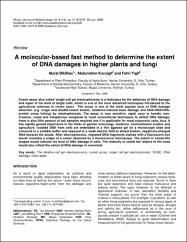A molecular-based fast method to determine the extent of DNA damages in higher plants and fungi
Abstract
Comet assay also called 'single cell gel electrophoresis is a technique for the detection of DNA damage and repair at the level of single cells, which is one of the most advanced techniques introduced to the agricultural sciences in recent years. The assay is one of the most popular tests of DNA damage detection (e. g. single and double-strand breaks, oxidative-induced base damage and DNA-DNA/DNA-protein cross linking) by electrophoresis. The assay is very sensitive, rapid, easy to handle, noninvasive, visual and inexpensive compared to most conventional techniques to detect DNA damage, there is also little amount of cell samples required and it is applicable for most eukaryotic cells, thus, it has rapidly gained importance in the fields of genetic toxicology, medicine, environmental studies and agriculture. Isolated DNA from cells are embedded in a thin agarose gel on a microscope slide and unwound in a suitable buffer and exposed to a weak electric field to attract broken, negatively-charged DNA towards the anode. After electrophoresis, migrated DNA fragments stained with a fluorescent dye would resemble a shape of a comet observed by a fluorescence microscopy. The extent of comet-like shapes would indicate the level of DNA damage in cells. The intensity of comet tail relative to the head would also reflect the extent of DNA damage in numerical.


















